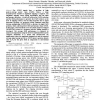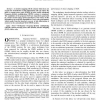52 search results - page 6 / 11 » Peak to Average Power Reduction for Low-Power OFDM Systems |
VTC
2008
IEEE
14 years 1 months ago
2008
IEEE
— A wireless body area network with an average throughput of 500 kbps is considered based on ultra-wideband (UWB) pulse position modulation. For a long battery autonomy ultra low...
VTC
2006
IEEE
14 years 21 days ago
2006
IEEE
—The OFDM signals have a problem of high peak-to-average power ratio (PAPR). Hence, a large transmit-power backoff or amplitude clipping is required. The amplitude clipping cause...
TWC
2010
13 years 1 months ago
2010
Abstract--One of the major drawbacks of orthogonal frequency division multiplexing (OFDM) signals is the high peak to average power ratio (PAPR) of the transmitted signal. Many PAP...
GLOBECOM
2006
IEEE
14 years 23 days ago
2006
IEEE
— Existing tone-reservation algorithms (such as the controlled clipper algorithm) for OFDM require a number of iterations to ensure the reduction of Peak-to-Average Power Ratio (...
TWC
2008
13 years 6 months ago
2008
A selective-mapping (SLM) scheme which does not require the transmission of side information and can reduce the peak to average power ratio (PAPR) in turbo coded orthogonal frequen...


